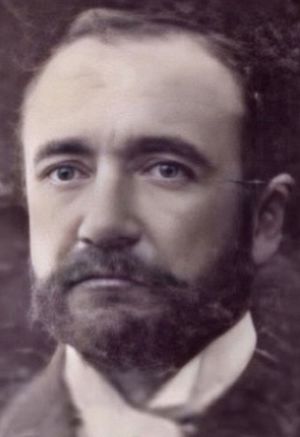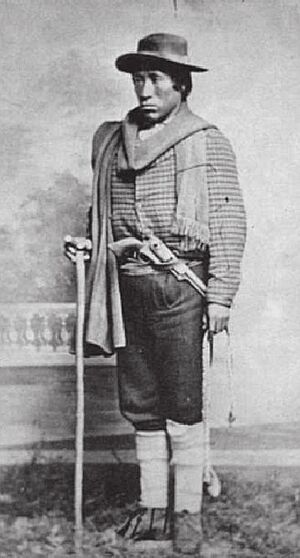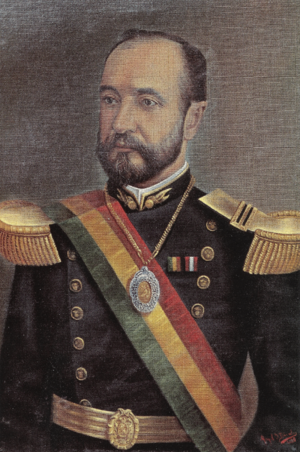José Manuel Pando facts for kids
Quick facts for kids
José Manuel Pando
|
|
|---|---|
 |
|
| 25th President of Bolivia | |
| In office 25 October 1899 – 14 August 1904 Junta: 12 April 1899 – 25 October 1899 |
|
| Vice President | Lucio Pérez Velasco Aníbal Capriles Cabrera |
| Preceded by | Severo Fernández |
| Succeeded by | Ismael Montes |
| Personal details | |
| Born | 27 December 1849 Luribay, La Paz, Bolivia |
| Died | 17 June 1917 (aged 67) La Paz, Bolivia |
| Political party | Republican (1914–1917) Liberal (1884–1914) |
| Spouse | Carmen Guarachi |
| Parents | Manuel Pando Petrona Solares |
| Education | Seminary School of La Paz |
| Signature | |
| Military service | |
| Allegiance | Bolivia |
| Branch/service | Bolivian Army |
| Years of service | 1871–1899 |
| Rank | General |
| Battles/wars | War of the Pacific Federal War Acre War |
José Manuel Pando Solares (born December 27, 1849 – died June 17, 1917) was a Bolivian soldier and explorer. He became the 25th President of Bolivia, serving from 1899 to 1904. During his time as president, the Acre War began. This was a conflict where Bolivia fought against Brazil over land.
Contents
Pando's Early Life
School Days and Early Career
José Manuel Pando was born in a town called Luribay on December 27, 1849. His parents were Manuel Pando and Petrona Solares. He went to the Colegio Seminario de La Paz for his early education. Later, he studied medicine at the Universidad Mayor de San Andrés (UMSA). However, he left his studies before finishing to start a career in politics.
When he was 23, Pando joined the people of La Paz to remove the government of Mariano Melgarejo. This happened on January 15, 1871. After this event, he joined the Bolivian Army.
A Soldier's Journey
After the government change, Bolivian President Agustín Morales chose Pando to be his personal assistant in 1871. Pando and Morales worked well together. This helped Pando's career in the army grow quickly. However, on November 27, 1872, President Morales was sadly killed. Pando was very upset and resigned from his position.
In 1876, after Hilarión Daza took over from President Tomás Frías, Pando left public life. He went to live on his farm in Luribay. But when the War of the Pacific started, he returned to serve in the army.
During the War of the Pacific, Pando helped the Bolivian Army. He worked to bring artillery (large guns) from the United States. This was a task given to him by General Daza. Pando fought in the Battle of Alto de la Alianza on May 26, 1880. He was badly hurt in his left arm and was captured by Chilean forces. He was taken as a prisoner to Santiago, Chile. When he returned to Bolivia, Pando led an artillery group until 1884.
Pando the Explorer
Pando was one of Bolivia's most important explorers in the 1800s. His journeys helped people learn a lot about Northern Bolivia. This area was then called the National Territory of Colonies. It was a largely unknown part of the country. Today, this region includes the departments of La Paz, Beni, and Pando. The Pando Department is named after him because of his explorations there.
He explored areas around the Madidi, Madre de Dios, and Mamoré rivers. His studies helped create better maps of Bolivia. He provided important information about unknown lands in the Amazon Rainforest.
Becoming a Politician
Joining the Liberal Party
Pando joined the Liberal Party in 1884. A political party is a group of people who share similar ideas about how the country should be run. He became the leader of the party in 1894, taking over from General Eliodoro Camacho. He remained the head of the Liberal Party until his presidency ended. Over time, Pando also became a very successful landowner in Bolivia.
As the leader of the Liberal Party, Pando ran for president in the 1896 elections. However, he lost to the Conservative Party and its leader, Severo Fernández. That same year, he became a senator for the Department of Chuquisaca.
Leading a Revolution
In 1898, Pando led a group called the Federalists. They rose up against the government. He gained the support of the Aymara people and a leader named Colonel Pablo Zárate Willca, also known as "Fearsome Willka." This started the Bolivian Civil War of 1898-1899.
After four months of fighting, Pando's forces won against President Fernández's conservative army. This victory happened at the Battle of the Segundo Crucero. A special group called the Federal Government Board was then created. Pando, Serapio Reyes Ortiz, and Macario Pinilla were part of this board. They moved the government's main office to La Paz. The board made some changes and built public works, like the government palace in La Paz. This board ended in 1899, and Pando was elected president.
President Pando
What Pando Did as President
Pando was 50 years old when he became president. During his time in office, Bolivia conducted its first census of the 1900s in 1900. A census counts all the people in a country. It was also found that Bolivia was earning more money from exports than it was spending on imports. This was due to a "rubber boom," which meant the economy would be strong for many years.
Pando ordered new roads to be built. These roads connected distant towns to the main cities in Bolivia. This helped to link the country and improve its transportation. Another important event was the arrival of the first imported car in Bolivia. It was brought to the country by an adventurer named Arthur Posnansky.
On the international stage, Pando led Bolivia in the Acre War against Brazil. The region of Acre was in the north, next to the border with Brazil. Brazilian settlers and rubber gatherers had moved into this area during the rubber boom. The Bolivian government wanted to show its control there. So, in 1899, they founded Puerto Alonso and started taxing the rubber gatherers.
However, the rubber gatherers rebelled. They started a movement called the First Revolution of Acre. The Bolivian government was able to stop this rebellion. The second part of this war, called the Second Acrean Revolution, happened in 1902. This time, the people in Acre asked to become part of Brazil.
The Bolivians faced difficulties against the Acrean revolutionaries. So, Pando personally led an army to Acre. This caused Brazil to get involved. Brazil believed the area belonged to them and sent their army to support the Acreans. Because of this difficult situation, Bolivia had to negotiate.
Pando signed the Treaty of Petrópolis with Brazil. In this treaty, Bolivia gave up territory in the north. In return, Bolivia received a large payment of two million pounds sterling. After returning to La Paz, Pando finished his term. He handed over power to Ismael Montes, who became the new leader of the Liberal Party.
Later Life and Passing
After his presidency, Pando worked as a delegate in the northern territories. He also helped set the borders with Brazil. In 1911, he was made a Brigadier General in the Army of Peru. He later left the Liberal Party and, in 1915, helped start the Republican Party.
Pando was found dead in a ravine near El Kenko (now El Alto) on June 17, 1917. Many people at the time thought it was a political crime. Some believed it was planned by the Liberal Party. A man named Alfredo Jáuregui was later shot in 1927 because he was thought to be involved in Pando's death.
However, newer investigations suggest that Pando's death might have been from natural causes. They believe he had a stroke while traveling from his farm to La Paz. According to this idea, some people found his body on the road. Fearing they would be blamed, they moved his body into the ravine.
See also
 In Spanish: José Manuel Pando para niños
In Spanish: José Manuel Pando para niños
- José Manuel Pando Province



